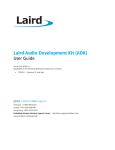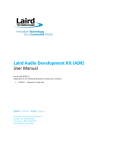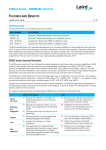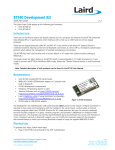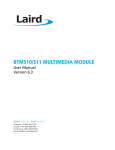Download Laird Audio Development Kit (ADK)
Transcript
Laird Audio Development Kit (ADK) User Guide v1.0 Part # DVK-BTM511 Applicable to the following Bluetooth module part numbers: BTM511 – Revision 07 and later Americas: +1-800-492-2320 Europe: +44-1628-858-940 Hong Kong: +852-2923-0610 Embedded Wireless Solutions Support Center: www.lairdtech.com/bluetooth http://ews-support.lairdtech.com Laird Audio Development Kit (ADK) User Guide REVISION HISTORY Revision Number Date Description Approver 1.0 10 July 2013 Initial Release Jonathan Kaye Embedded Wireless Solutions Support Center: http://ews-support.lairdtech.com www.lairdtech.com/bluetooth Laird 2 Americas: +1-800-492-2320 Europe: +44-1628-858-940 Hong Kong: +852-2923-0610 Laird Audio Development Kit (ADK) User Guide CONTENTS Laird Audio Development Kit (ADK) .......................................................................................................... 4 1. Overview ................................................................................................................................................ 4 1.1 Introduction ................................................................................................................................... 4 1.2 Package Contents .......................................................................................................................... 4 2 ADK – Main Development Board ......................................................................................................... 5 3 Getting to know the Development Board .......................................................................................... 5 4 Power Supply ......................................................................................................................................... 6 5 USB - RS232 Serial Interface .................................................................................................................. 7 6 Software ................................................................................................................................................. 8 7 Interface Specification .......................................................................................................................... 9 8 9 7.1 RS232 Serial signals ........................................................................................................................ 9 7.2 PCM / I2S ..................................................................................................................................... 10 7.3 Differential input – J12 on ADK, labeled DIFF_IN .......................................................................... 10 7.4 SPI Interface - J16 on ADK, labeled SPI ......................................................................................... 10 7.5 Audio Connectors – Labeled LINE_In, MIC_IN and STEREO_OUT .................................................. 10 7.6 Push Buttons ................................................................................................................................ 11 7.7 Board Configuration Jumpers ....................................................................................................... 11 7.8 SW – Switches.............................................................................................................................. 13 Other Features ..................................................................................................................................... 13 8.1 Power Consumption Measurement .............................................................................................. 13 8.2 USB Access ................................................................................................................................... 14 Additional Documentation ................................................................................................................. 14 Embedded Wireless Solutions Support Center: http://ews-support.lairdtech.com www.lairdtech.com/bluetooth Laird 3 Americas: +1-800-492-2320 Europe: +44-1628-858-940 Hong Kong: +852-2923-0610 Laird Audio Development Kit (ADK) User Guide LAIRD AUDIO DEVELOPMENT KIT (ADK) Part # DVK-BTM511 Applicable to the following Bluetooth module part numbers: BTM511 Revision -07 onwards 1. OVERVIEW Laird’s Audio Development Kit (ADK) provides a platform for rapid wireless connectivity prototyping, providing multiple options for the development of Bluetooth stereo and mono audio applications. This manual is for the first production release of the development board PCB and relates to BTM511 DVK-V04 on the PCB itself. The complete functionality of the ADK hardware requires the use of Laird BTM511 firmware revision -07 (firmware v18.1.3.0) or greater. 1.1 Introduction The Laird ADK is designed to support the rapid development of applications and software for the specific Laird Bluetooth module part number BTM511. More information regarding this product including a detailed module User’s Manual is available from the following link: http://www.lairdtech.com/products/btm51x-series. 1.2 Package Contents All kits contain the following items: Development Board The motherboard has the BTM511 module already soldered onto it and exposes all the various hardware interfaces available. USB cable – Type A to Type B The USB cable is one option for providing power for the ADK via the on-board connector. The cable also provides serial communications via a FTDI USB – RS232 converter chip. 3.5 mm Audio cable The audio cable is one option for connecting one of the Line in / MIC / Speaker ports to an external media device with 3.5mm audio jack socket. Web link Card Provides links to additional information including the BTM511 User Manual, terminal utilities, schematics, quick start guides and firmware release notes. Embedded Wireless Solutions Support Center: http://ews-support.lairdtech.com www.lairdtech.com/bluetooth Laird 4 Americas: +1-800-492-2320 Europe: +44-1628-858-940 Hong Kong: +852-2923-0610 Laird Audio Development Kit (ADK) User Guide 2 ADK – MAIN DEVELOPMENT BOARD The development board allows the Laird Bluetooth module to connect to a PC. The development board provides USB-to-Virtual COM port conversion through a FTDI chip. Any Windows PC (XP or later) auto-installs the necessary drivers; if your PC cannot locate the drivers, you can download them from http://www.ftdichip.com/FTDrivers.htm GETTING TO KNOW THE DEVELOPMENT BOARD 3 SW 7 – Left Channel Input RS232 SW8 – Right Channel Input Differential Input USB Line Input MIC Input DC Jack Speaker Figure 1: Main ADK Board Reset Embedded Wireless Solutions Support Center: http://ews-support.lairdtech.com www.lairdtech.com/bluetooth PCM/I2S SPI Laird 5 Americas: +1-800-492-2320 Europe: +44-1628-858-940 Hong Kong: +852-2923-0610 Laird Audio Development Kit (ADK) User Guide 4 POWER SUPPLY Input Voltage Minimum Typical Maximum 4.5 V 5V 5.5 V The development board has two options for providing power to the module: 5V power from a USB port Power from an external mains power block via a 2.0 mm DC connector The developer kit includes a USB cable to provide power to the development board. It should be plugged into a PC USB port, a USB hub, or a mains adaptor with a USB output. If a hub is used, it should be a powered USB hub to ensure that sufficient current is available at the port being used. The BTM511 module can be driven by the current available at a standard USB port. Switch SW1 is used to select between USB or DC jack power source. Figure 2: SW1 Settings SW1 (slide switch) provides the selection of input power for BTM511 module from USB or DC jack. The power for the U3 (FT232R) is always powered by the USB bus. SW2 (push button TACT switch) provides a reset signal to the BTM511 module. Embedded Wireless Solutions Support Center: http://ews-support.lairdtech.com www.lairdtech.com/bluetooth Laird 6 Americas: +1-800-492-2320 Europe: +44-1628-858-940 Hong Kong: +852-2923-0610 Laird Audio Development Kit (ADK) User Guide 5 USB - RS232 SERIAL INTERFACE The ADK provides USB-to-Virtual COM port conversion through a FTDI chip and any Windows PC (XP or later) will auto install the necessary drivers and if your PC cannot locate the drivers, you can download them from http://www.ftdichip.com/FTDrivers.htm The development board contains a USB to UART interface on the RX, TX, CTS, RTS, DTR, DSR, RI, and DCD signals. In default setting, the FTDI is on by having the J8 open (no jumper), so providing a USB to virtual COM port for evaluation through standard USB cable. See Figure 3. The UART interface on the BTM511 module can be driven from external microcontroller instead of the on-board FTDI FT232R chip (U3), if the DVK is powered from DC jack and SW1 (Figure 2) is in position ‘DC’. At a minimum, RX, TX, RTS, and CTS need to be connected (J15) for this use case. Modem control lines (J19) are optional. Figure 3: USB to UART Interface Embedded Wireless Solutions Support Center: http://ews-support.lairdtech.com www.lairdtech.com/bluetooth Laird 7 Americas: +1-800-492-2320 Europe: +44-1628-858-940 Hong Kong: +852-2923-0610 Laird Audio Development Kit (ADK) User Guide 6 SOFTWARE The development board connects the BTM511 module to a virtual COM port of a PC or other device. From a PC, you can communicate with the module using any Terminal Emulator software, such as HyperTerminal, Procomm, or the supplied EZURiO / Laird Terminal application. EZURiO / Laird Terminal is a terminal emulation application capable of running on Windows 98, Me, 2000, XP, Windows 7 and Windows 8 operating systems. It was developed specifically to aid development and testing of Laird modules. It allows connection to serial devices using any combination of the communications parameters listed in Table 1. Table 1: Communication Parameters COM Port 1 to 255 Baud rate 300 to 921600 Parity None, Odd, Even Data Bits 7 or 8 Stop Bits 1 or 2 Handshaking None or CTS/RTS The benefits of using EZURiO / Laird Terminal include: Continually displayed status of DSR, CTS, DCD, and RI Direct control of DTR on the host PC via a check box Direct control of RTS Sending of BREAK signals Scripts can be run to assist Additional built-in features accelerate development Laird includes a “Data Transfer Test” mode allowing data to be sent as fast as the handshaking permits. This feature is useful for testing the bit transfer rate of a Bluetooth connection. The EZURiO / Laird Terminal application can be downloaded from the Software Downloads tab of the BTM51x webpage: http://www.lairdtech.com/products/btm51x-series. You will need to login or register for access. Embedded Wireless Solutions Support Center: http://ews-support.lairdtech.com www.lairdtech.com/bluetooth Laird 8 Americas: +1-800-492-2320 Europe: +44-1628-858-940 Hong Kong: +852-2923-0610 Laird Audio Development Kit (ADK) User Guide 7 INTERFACE SPECIFICATION 7.1 RS232 Serial signals The digital RS232 Serial signals are contained in J15/J19 as shown in Table 2. Note: The direction is from the module’s perspective. Table 2: RS232 Definitions J15 Signal J15 Description Direction Shared with Pin-1 GND Ground - - Pin-2 RTS Request To Send Output - Pin-3 NC No Connection - - Pin-4 RXD Receive Data Input - Pin-5 TXD Transmit Data Output - Pin-6 CTS Clear To Send Input - J19 Signal J19 Description Pin-1 DCD Data Carrier Detect Output GPIO2 Pin-2 DTR Data Terminal Ready Output GPIO8 Pin-3 DSR Data Set Ready Input GPIO3 Pin-4 RI Ring Indicator Output GPIO4 Direction Shared with The format of the holes allows the fitting of your choice of connectors, or can be used for directly soldering test wires to the board. Pins are laid out on a standard 2.54 mm (0.1 inch) pitch. Embedded Wireless Solutions Support Center: http://ews-support.lairdtech.com www.lairdtech.com/bluetooth Laird 9 Americas: +1-800-492-2320 Europe: +44-1628-858-940 Hong Kong: +852-2923-0610 Laird Audio Development Kit (ADK) User Guide 7.2 PCM / I2S The development board provides for a PCM / I2S interface for the BTM511. The pins provide the developer with access to the module’s I2S or PCM lines, as well as providing power for additional audio hardware to be developed. I2S signals are mapped to the PCM pins of BTM51x as outlined in this table: Table 3: BTM51x pins and I2S Signals I2S Signal Name BTM51x Signal Name BTM51x Module Pin Number ADK Header (J18) Comment SD_IN PCM_IN 3 5 I2S Serial data in SD_OUT PCM_OUT 4 7 I2S Serial data out WS PCM_SYNC 5 6 I2S Word select (right/left ch) SCK PCM_CLK 6 4 I2S clock GND1/2/3/4 [9,22,13,47] 10 GND Note: For backward compatibility reasons, remaining pins of J18 are connected to signals that are not directly related to PCM/I2S functions. 7.3 Differential input – J12 on ADK, labeled DIFF_IN If the audio input should be driven by a differential audio source rather than a single-ended signal, J12 allows connecting non-inverted (‘P’) and inverted (‘N’) signal of the source to BTM511, as well as AGND (analogue GND) for left and for right channel. In addition, SW7 and SW8 must be set to middle position “DIFF”. Differential signals provide better audio quality due to better noise immunity. 7.4 SPI Interface - J16 on ADK, labeled SPI This interface is only utilized for Laird’s internal use and production testing. We do not recommend that the OEM use these pins. Note: J14, J13 (labelled SPI/VCC) and J4 are similarly only used for Laird internal use in manufacturing test. 7.5 Audio Connectors – Labeled LINE_In, MIC_IN and STEREO_OUT These 3.5 mm audio connectors on the right side of the ADK allow OEMs to connect standard speakers, microphones and headphones. Embedded Wireless Solutions Support Center: http://ews-support.lairdtech.com www.lairdtech.com/bluetooth Laird 10 Americas: +1-800-492-2320 Europe: +44-1628-858-940 Hong Kong: +852-2923-0610 Laird Audio Development Kit (ADK) User Guide 7.6 Push Buttons Table 4: Push buttons Push Button Label on ADK PCB SW2 RESET Button to reset the BTM511 module SW3 GPIO 5 Push button for use of associated GPIO line for a range of configurable functionality SW4 GPIO 1 Push button for use of associated GPIO line for a range of configurable functionality SW5 GPIO 7 Push button for use of associated GPIO line for a range of configurable functionality Note: Contrary to remaining push buttons, the pull-up resistor (R29) for GPIO 7 is not fitted per default. In future use, GPIO7 may function as an output to control the audio amplifier (U7), see J9. SW6 GPIO 6 Push button for use of associated GPIO line for a range of configurable functionality Description 7.7 Board Configuration Jumpers Table 5: Jumpers Jumper Label on ADK PCB J1 – J3 N/A J4 J4 INTERNAL USE ONLY. J5 J5 Provides provide voltage drop on 3.3 V across 0.25 ohm to measure the current for the BTM511 module when open. J6 J6 Place a jumper on the middle and left side pins for 3.3 V operation. Place a jumper on the middle and right side pins for 1.8 V operation. J7 J7 INTERNAL USE ONLY. J8 RS232-OFF J8 Unused on the development board. Default state is J8 open (no jumper) for use with USB power and on board FTDI. Alternatively, the UART interface on the BTM511 module can be driven from external microcontroller instead of the on-board FTDI FT232R chip (U3) by powering the DVK via DC jack and setting SW1 (Figure 2) to ‘DC’. At a minimum RX, TX, RTS, CTS and GND need to be connected (J15) for this use case. J9 GPIO7 Place a jumper on the middle and left side pins to set audio amplifier enabled pin to 3.3 V. Place a jumper on the middle and right side pins to set audio amplifier to be controlled by GPIO-7. Note: This second option is not implemented in current firmware version 18.1.3.0. J10 J10 Place jumper across J10 / J11 (closed) to select audio amplifier gain as listed on silkscreen table below J11. J11 J11 Place jumper across J10 / J11 (closed) to select audio amplifier gain as listed on silkscreen table below J11. J12 DIFF_IN J13 J13 INTERNAL USE ONLY. J14 N/A INTERNAL USE ONLY. J9 J15 Description 3.3V J15 Embedded Wireless Solutions Support Center: http://ews-support.lairdtech.com www.lairdtech.com/bluetooth Differential stereo audio input. Through hole plated UART interface for use when direct access to the Laird 11 Americas: +1-800-492-2320 Europe: +44-1628-858-940 Hong Kong: +852-2923-0610 Laird Audio Development Kit (ADK) User Guide Jumper Label on ADK PCB Description UART pins from an external microcontroller. UART pins supported on J15 are GND, RTS, NC, RXD, TXD, CTS. Additional UART lines on J19. Please see notes on J8. J16 SPI J17 J17 3V3 INTERNAL USE ONLY. Place a jumper on left hand side and middle pins to set VDDIO to 3.3 V. Place a jumper on middle and right hand side pins to set VDDIO to 1.8 V. 1V8 J18 PCM / I2S Please see the PCM / I2S section. J19 J19 Through hole plated UART interface (modem control lines) for use when direct access to the UART pins from an external microcontroller is required. UART pins supported on J19 are DCD, DTR, DSR and RI. Additional UART lines on J15. Please see notes on J8. J20 USB_D+ J21 J21 USB_D- Embedded Wireless Solutions Support Center: http://ews-support.lairdtech.com www.lairdtech.com/bluetooth USB access can be provided to allow a direct USB connection to a Bluetooth HCI module. Note: If this is done and the unit is connected to a USB host port, it will be powered from that same port. Do not attempt to use any other power source for the development kit when operating in this mode. This is not relevant for modules with a UART interface. Do not close J21 by placing a jumper. J21 is not fitted by default to prevent a short circuit caused by accidentally closing the headers with a jumper. Full details are available in Section 8.1 Laird 12 Americas: +1-800-492-2320 Europe: +44-1628-858-940 Hong Kong: +852-2923-0610 Laird Audio Development Kit (ADK) User Guide 7.8 SW – Switches SW1 Is the power switch on board the BTM51X DVK. Its function is explained in Table 6. Table 6: SW1 Position Switch Label on ADK PCB Description SW1 DC Switch to select power input from DC jack or USB connector. USB SW7 and SW8 control which input lines are connected to the BTM510 / 511 module. The positioning of the switch determines whether the channel is placed in Line, Diff, or Mic mode and therefore what signal lines are connected. Table 7 explains the function of SW7 and SW8. Table 7: SW7 and SW8 positions SW8 Position BTM511 Input Signals (Left Channel) MIC_AN_C MIC_AP_C LINE (Top) CON4-2 (Line_IN) AGND DIFF (Middle) J12-3 (DIFF_IN / L_N) J12-2 (DIFF_IN / L_P) MIC(Bottom) CON5-2 (MIC_IN) CON5-1 (MIC_IN / AGND) SW7 Position BTM511 Input Signals (Right Channel) MIC_BN_C MIC_BP_C LINE (Top) CON4-3 (Line_IN) AGND DIFF (Middle) J12-6 (DIFF_IN / R_N) J12-5 (DIFF_IN / R_P) MIC(Bottom) AGND AGND 8 OTHER FEATURES 8.1 Power Consumption Measurement J21, pin 2 provides the output voltage of current sensing amplifier U17 (INA216A4). Current is measured by voltage drop over the parallel resistors R64, R65 (0.51 Ohm each). R64 and R65 can be seen as one 0.255 Ohm resistor. With the gain of U17, which is 200, the following formula results: I = ((voltage_J21 / 200) / 0.255) A Or simplified: I = (voltage_J21 / 51) A Note 1: The parameters of this DVK are optimised for measuring average low currents. If the intention is to measure current patterns (e.g. for sniff mode investigation, higher currents), the bandwidth of this design (response to fast changing currents) is insufficient. In that case, a current-sensing amplifier with less gain but higher bandwidth should be utilised (see INA216A data sheet). J5 allows to do this externally. Note 2: This only measures the current consumption of the module, and not of the level shifter or other peripheral circuitry. Embedded Wireless Solutions Support Center: http://ews-support.lairdtech.com www.lairdtech.com/bluetooth Laird 13 Americas: +1-800-492-2320 Europe: +44-1628-858-940 Hong Kong: +852-2923-0610 Laird Audio Development Kit (ADK) User Guide 8.2 USB Access USB access can be provided to allow a direct USB connection to a Bluetooth HCI module. To enable this operation, close J8 by placing a jumper on the pins. If this is done and the unit is connected to a USB host port, it will be powered from that same port. Do not attempt to use any other power source for the development kit when operating in this mode. Note: This is not relevant for modules with a UART interface. 9 ADDITIONAL DOCUMENTATION Laird offers a variety of documentation and ancillary information to support our customers through the initial evaluation process and ultimately into mass production. Software and documentation are available on the BTM51X product page at http://www.lairdtech.com/products/BTM51X-series. Additional documentation includes: BTM511 – Class 2 Audio Multimedia Module – Datasheet BTM510 / 511 – User Manual Firmware Release Notes – BTM510 / 511 to v18.1.x.x ADK – Audio Development Kit - Schematics BTM511 – ADK – Quick Start Guide – A2DP & AVRCP BTM511 – ADK – Quick Start Guide – HFP BTM511 – ADK – Quick Start Guide – SPP For any additional question or queries or to receive local technical support for the ADK or BTM511 module, please contact [email protected]. Copyright © 2015 Laird Technologies, Inc. All rights reserved. The information contained in this manual and the accompanying software programs are copyrighted and all rights are reserved by Laird Technologies, Inc. Laird Technologies, Inc. reserves the right to make periodic modifications of this product without obligation to notify any person or entity of such revision. Copying, duplicating, selling, or otherwise distributing any part of this product or accompanying documentation/software without the prior consent of an authorized representative of Laird Technologies, Inc. is strictly prohibited. All brands and product names in this publication are registered trademarks or trademarks of their respective holders. This material is preliminary Information furnished by Laird Technologies in this specification is believed to be accurate. Devices sold by Laird Technologies are covered by the warranty and patent indemnification provisions appearing in its Terms of Sale only. Laird Technologies makes no warranty, express, statutory, and implied or by description, regarding the information set forth herein. Laird Technologies reserves the right to change specifications at any time and without notice. Laird Technologies’ products are intended for use in normal commercial and industrial applications. Applications requiring unusual environmental requirements such as military, medical life-support or life-sustaining equipment are specifically not recommended without additional testing for such application. Limited Warranty, Disclaimer, Limitation of Liability Embedded Wireless Solutions Support Center: http://ews-support.lairdtech.com www.lairdtech.com/bluetooth Laird 14 Americas: +1-800-492-2320 Europe: +44-1628-858-940 Hong Kong: +852-2923-0610














